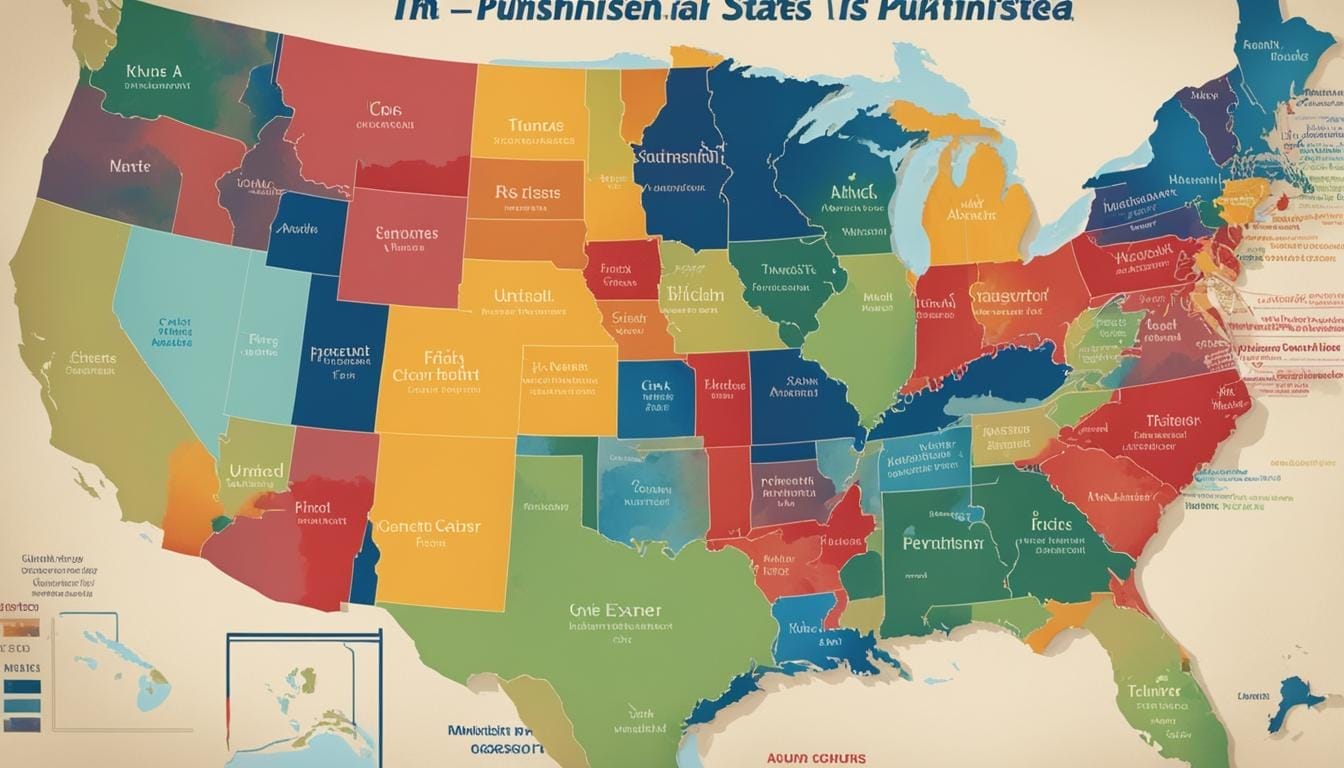School corporal punishment is currently legal in 19 states, and over 160,000 children in these states are subject to corporal punishment in schools each year.
The states that allow school corporal punishment are Alabama, Arkansas, Arizona, Colorado, Florida, Georgia, Idaho, Indiana, Kansas, Kentucky, Louisiana, Missouri, Mississippi, North Carolina, Oklahoma, South Carolina, Tennessee, Texas, and Wyoming.
However, it is important to note that exercise as punishment is deemed illegal in certain states, with specific laws and regulations in place regarding the use of physical activity as discipline. This article will explore the legality of using exercise as punishment in different states and the potential legal consequences for those who engage in this practice.
Key Takeaways:
- Exercise as punishment is illegal in certain states.
- Specific laws and regulations govern the use of physical activity as discipline in schools.
- Those who use exercise as punishment in states where it is illegal may face legal consequences.
- Understanding state laws is crucial for educators and administrators to ensure compliance.
- Positive discipline strategies should be prioritized to create a safe and respectful learning environment.
Exercise punishment laws vary from state to state, and educators and administrators need to understand the legal implications of using exercise as discipline in their respective states. The next section will delve into the legal restrictions surrounding exercise as punishment and provide insights into the specific guidelines and limitations in different states.
Legal Restrictions on Exercise as Punishment
When it comes to using exercise as punishment in schools, each state has its own set of laws and regulations. While corporal punishment may be allowed in some states, exercise as a disciplinary measure may be explicitly banned or restricted. Educators and administrators must familiarize themselves with the specific guidelines and restrictions in their state to ensure compliance with the law.
Some states have outright bans on using exercise as punishment, while others impose limitations on the types or duration of physical activity that can be used for disciplinary purposes. By understanding these laws and regulations, educators can ensure they employ appropriate disciplinary practices.
Laws Against Using Exercise as Discipline by State
The following table provides an overview of exercise punishment restrictions by state and whether exercise is banned as a form of discipline:
| State | Exercise Punishment Restrictions |
|---|---|
| Alabama | Restricted |
| Arkansas | Allowed |
| Arizona | Banned |
| Colorado | Restricted |
| Florida | Allowed |
| Georgia | Banned |
| Idaho | Banned |
| Indiana | Allowed |
| Kansas | Banned |
| Kentucky | Restricted |
| Louisiana | Allowed |
| Missouri | Banned |
| Mississippi | Banned |
| North Carolina | Restricted |
| Oklahoma | Banned |
| South Carolina | Restricted |
| Tennessee | Banned |
| Texas | Allowed |
| Wyoming | Banned |
Educators should note that this table provides a general overview, and it is essential to consult the laws and regulations specific to their state for a comprehensive understanding.
The Consequences of Using Exercise as Punishment
The use of exercise as punishment can have serious legal consequences, especially in states where it is prohibited. Educators or administrators who use exercise as a form of punishment in states where it is illegal can face disciplinary action, including loss of their teaching license or job.
Additionally, parents or guardians may have legal recourse if they believe their child has been subjected to unlawful punishment. It is important for educators to understand the potential legal consequences and the impact it can have on their professional and personal lives.
To shed light on this issue, let’s take a closer look at the legal implications of using exercise as punishment in certain states:
State Law Case Studies
To illustrate the legal consequences of using exercise as punishment, here are two case studies highlighting the legal frameworks in states where exercise as punishment is deemed illegal:
| State | Legal Status | Consequences for Violation |
|---|---|---|
| California | Illegal | Educators or administrators found using exercise as punishment may face legal action, including fines and potential litigation from parents or guardians. |
| Massachusetts | Illegal | Using exercise as punishment can result in disciplinary measures, such as reprimands, suspension, or termination of employment. |
These case studies demonstrate the potential legal consequences for using exercise as punishment in states where it is expressly prohibited. Educators and administrators must be aware of the laws in their state and comply with alternative disciplinary methods that align with state regulations.
Instead of resorting to exercise as punishment, educators should explore alternative disciplinary approaches focusing on positive reinforcement, restorative justice, and teaching students valuable life skills. By promoting a supportive and inclusive learning environment, educators can foster the growth and development of their students without risking the legal consequences associated with using exercise as punishment.
The Importance of Positive Discipline in Schools
The use of exercise as punishment raises important questions about the overall approach to discipline in schools. Instead of relying on physical activity as a disciplinary tool, educators and administrators should focus on implementing positive discipline strategies that promote a safe and respectful learning environment.
Positive discipline emphasizes teaching and modeling appropriate behavior, setting clear expectations, and providing meaningful consequences that support students’ growth and development. By adopting positive discipline strategies, schools can create a nurturing and inclusive educational environment that enhances students’ overall well-being and academic success.
Positive discipline strategies can include:
- Effective communication and active listening to address student behavior issues
- Implementing restorative practices to resolve conflicts and promote empathy and understanding
- Encouraging student participation in establishing classroom rules and expectations
- Providing consistent and fair consequences that are age-appropriate
- Teaching problem-solving skills and promoting self-reflection
By focusing on positive discipline, schools can create an environment where students feel respected and safe, fostering a sense of belonging and empowering them to take responsibility for their actions. This approach helps to build positive relationships between students and educators, promoting a supportive learning community.
| State | Laws Against Using Exercise as Discipline | State Regulations on Exercise as Disciplinary Action |
|---|---|---|
| California | Exercise cannot be used as a form of punishment in schools | Exercise can only be used for physical education or health-related purposes |
| New York | Exercise cannot be used as a disciplinary measure in schools | There are specific guidelines for physical activity in schools, but exercise cannot be used as punishment |
| Illinois | Using exercise as punishment is prohibited in schools | Teachers must follow approved disciplinary practices that do not involve exercise |
| Texas | Exercise cannot be used as a disciplinary tool in schools | There are state regulations on the use of physical activity as discipline in schools |
| Florida | Exercise is not allowed as a form of punishment in schools | State regulations outline alternative disciplinary measures that should be used |
The table above provides examples of states that have laws against using exercise as discipline and their respective regulations on exercise as a form of disciplinary action. Educators and administrators must be aware of these laws and regulations in their state to ensure compliance and promote positive discipline practices.
Creating a Positive Learning Environment
Schools can create a supportive atmosphere that promotes student engagement, well-being, and academic achievement by fostering a positive learning environment through positive discipline practices. This approach not only benefits individual students but also contributes to the overall success of the school community.
Conclusion
The use of exercise as punishment in schools is illegal in certain states, with laws and regulations in place to protect the well-being and safety of students. Educators and administrators need to be aware of the specific laws in their state to ensure compliance and prioritize positive discipline strategies. Schools can create a positive and supportive learning environment that promotes student growth and success by shifting away from punitive approaches and focusing on fostering respectful behavior and teaching valuable life skills.
It is crucial to prioritize the well-being and rights of students, ensuring that their educational experience is free from harmful practices such as exercise as punishment. By embracing alternative disciplinary methods that align with state laws and regulations, schools can create a nurturing environment where students academically and emotionally thrive.
By adhering to the legality of using exercise as punishment and adopting positive discipline strategies, schools can create a safe and inclusive educational environment that fosters students’ overall well-being and promotes a love for learning.
FAQ
How is the Use of Corporal Punishment in Public Schools Regulated in the United States?
This question explores the legality of corporal punishment in public schools, focusing on how various states regulate the use of physical punishment of children within the educational system.
Which States Still Allow Corporal Punishment in Schools and Under What Conditions?
This question addresses the specific states that continue to permit corporal punishment in schools, detailing the conditions and regulations under which such punishment can be administered to children.
What are the Differences in Laws Regarding Corporal Punishment in Public vs. Private Schools?
This question delves into the disparities in legal regulations surrounding the use of corporal punishment in public schools compared to private schools across different states in the U.S.
How Has the Use of Corporal Punishment in Schools Evolved Over Time in the United States?
This question examines the historical evolution of corporal punishment in American schools, focusing on how its prevalence and legal status have changed over time.
Are There Any National Initiatives to End All Corporal Punishment in U.S. Schools?
This question seeks information about any nationwide efforts or initiatives aimed at ending the practice of corporal punishment in all American schools.
What Legal Recourse Do Parents Have if Their Child Receives Corporal Punishment in School?
This question explores the legal options available to parents whose children have been subjected to corporal punishment in school, especially in states where such punishment is allowed.
How Does the Administration of Corporal Punishment Differ Among Various States?
This question investigates the differences in how corporal punishment is administered in schools across various states, including disparities in its application based on factors like race and gender.
What are the Psychological and Educational Impacts of Corporal Punishment on Children?
This question addresses the consequences of corporal punishment on children’s psychological well-being and educational outcomes, exploring the debate around the effectiveness and ethical considerations of such disciplinary practices.
How Do International Laws and Conventions View the Use of Corporal Punishment in Schools?
This question examines the stance of international laws and conventions on the use of corporal punishment in educational settings, highlighting how the U.S. compares to global norms and standards.
What are the Arguments For and Against the Use of Corporal Punishment in School Discipline?
This question delves into the ongoing debate regarding the use of corporal punishment in schools, presenting the perspectives of both proponents and opponents of this disciplinary practice.
In States Where Corporal Punishment is Legal, What Training Do Educators Receive on Its Administration?
This question explores the training and guidelines provided to educators in states where corporal punishment is legal, focusing on how they are instructed to administer such punishment appropriately and safely.
How Do State Laws Define and Regulate Reasonable vs. Excessive Corporal Punishment?
This question seeks clarity on how different state laws in the U.S. define and distinguish between reasonable and excessive corporal punishment, providing insights into the legal boundaries of this disciplinary practice.
What Are the Trends in the Prevalence of School Corporal Punishment Across Different Demographics?
This question investigates the trends in the prevalence and application of corporal punishment in schools across different demographics, including racial and socioeconomic groups, highlighting any disparities or biases in its use.













